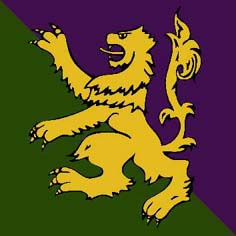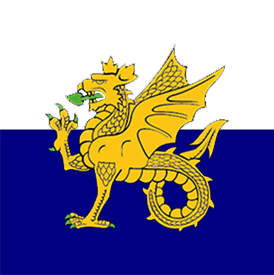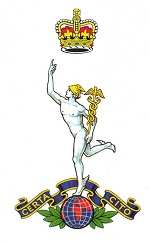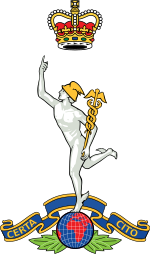
The Royal Corps of Signals is one of the combat support arms of the British Army. Signals units are among the first into action, providing the battlefield communications and information systems essential to all operations. Royal Signals units provide the full telecommunications infrastructure for the Army wherever they operate in the world. The Corps has its own engineers, logistics experts and systems operators to run radio and area networks in the field. It is responsible for installing, maintaining and operating all types of telecommunications equipment and information systems, providing command support to commanders and their headquarters, and conducting electronic warfare against enemy communications.

The 32nd Signal Regiment is a British Army Reserve Regiment of the Royal Corps of Signals. The regiment forms part of 1st Signal Brigade, providing military communications for national operations.

HQ 51st Infantry Brigade and Headquarters Scotland is a Regional Point of Command, Brigade of the British Army.
The Queen's Own Warwickshire and Worcestershire Yeomanry (QOWWY) was a regiment of the Royal Armoured Corps, forming part of the Territorial Army (TA). Following reductions in 1969 and 1971 respectively the regiment was reduced to two and later one company sized sub-unit in 1999. Following a reorganisation in 2021, there are now two successors to the regiment: one squadron in the Royal Yeomanry as light cavalry, and one squadron in the 37th Signal Regiment as a support squadron.

The 2nd Signal Brigade, was a military formation of the British Army composed of Royal Corps of Signals units. The brigade was first formed following the reorganisation of the old Territorial Army in 1967, and was disbanded in 2012 under the Army 2020 programme. However, later the 2nd Signal Group was formed continuing the lineage of the old brigade, before it was disbanded in 2018.

562 Parachute Squadron Royal Corps of Transport (Volunteers) was a minor unit that supported 44th Parachute Brigade (V).

36 (Eastern) Signal Regiment was a Territorial Army (TA) signal unit of the British Army's Royal Corps of Signals (RCS). The regiment was formed following the formation of the TAVR in 1967, and was disbanded in 2009 following a reorganisation in the RCS. Though not disbanded, the regiment continues its lineage as a squadron, with its own former squadrons forming troops within said squadron.

The 31st Signal Regiment was a territorial communications regiment of the British Army's Royal Corps of Signals. The regiment first formed following the creation of the Territorial and Army Volunteer Reserve in 1967 after the 1966 Defence White Paper. After seeing limited reserve support during the Cold War, the regiment was disbanded in 2010 following the initial Army 2020 reform.

37th Signal Regiment is a military communications regiment of the Royal Corps of Signals, part of the British Army. The regiment was one of ten Territorial Army,, units formed following the complete reorganisation of the Territorial Army in 1967. Until the Army 2020 programme in 2012, the regiment provided national communications support and its squadrons providing support to the regional brigades, notable 143rd and 160th (Welsh) Brigades. However, from 2014 the regiment was re-roled and now paired with 2nd Signal Regiment supporting 1st Division.

40 (Ulster) Signal Regiment (Volunteers) was a Territorial Army regiment in the Royal Corps of Signals in the British Army. The regiment formed part of 2 Signal Brigade, providing military communications for national operations. The regiment did not have an internal security role in Northern Ireland.

Gordon Barracks is a military installation situated in Bridge of Don, Aberdeen.

The 1st Signal Brigade, formerly known as the 1st Signal Group, is a brigade of the British Army. The group was first formed in 1968 as a result of the 1966 Defence White Paper which expanded support for NATO and the British Army of the Rhine. In 1987, the group was disbanded and merged into the 2nd Signal Brigade. In 1995, the brigade was reformed and has since deployed on operations across the globe in support of NATO and HQ Allied Rapid Reaction Corps.
London District Signals was a headquarters signal unit of the Royal Engineers (RE) and later Royal Corps of Signals in Britain's Territorial Army from 1908. It served with a corps headquarters at Gallipoli and on the Western Front during World War I, and later became an air defence signal unit during World War II. Its successor unit continues in the Army Reserve today.

The Dundee Fortress Royal Engineers was a Scottish volunteer unit of the British Army formed in 1908. Its main role was the defence of the harbours and shipyards on the River Tay, but it also provided a detachment that saw active service in North Russia at the end of World War I. In the 1930s, it was turned into an air defence unit, in which role it served in World War II. A brief postwar revival ended in disbandment in 1950.
The 1st Lancashire Engineer Volunteer Corps was a Volunteer unit of Britain's Royal Engineers, first raised in 1860. It went on to spin off a unit of fortress engineers and provided a signals training centre during the First World War. Its successor units provided signal support for West Lancashire Territorial Army (TA) formations in the early stages of the Second World War, and for Eighth Army HQ during the Second Battle of El Alamein, the advance to Tunis, invasion of Sicily and through Italy, ending the war in Austria. Postwar successor units have continued in the TA and Army Reserve to the present day.

525th (Antrim) Coast Regiment, Royal Artillery (TA) was a volunteer coastal defence unit of Britain's Territorial Army from 1937 until 1956. It was the first Territorial Army unit to be raised in Northern Ireland.

The City of London Signals was a Territorial Army unit of the British Army's Royal Corps of Signals. It had its origins in a signal company of the Royal Engineers formed in 1908 and during World War II it provided the divisional signals for the 56th (London) Division and its duplicates as well as communications for the Royal Air Force in the Middle East. Its successors continued in the postwar Territorial Army and Army Reserve until 2016.

43 (Wessex) Signal Regiment was a Territorial Army (TA) unit of the British Army's Royal Corps of Signals from 1920. It had its origins in a Volunteer unit of the Royal Engineers formed in the West Country in 1860 and provided the communications for the 43rd (Wessex) Infantry Division during World War II. Its successor still serves as a squadron in today's Army Reserve.

85 (Ulster) Signal Squadron was a military communications unit of the British Territorial Army, which formed part of the Royal Corps of Signals. The squadron was one of four signal squadrons which formed part of 40th (Ulster) Signal Regiment until its disbandment in 2009.














